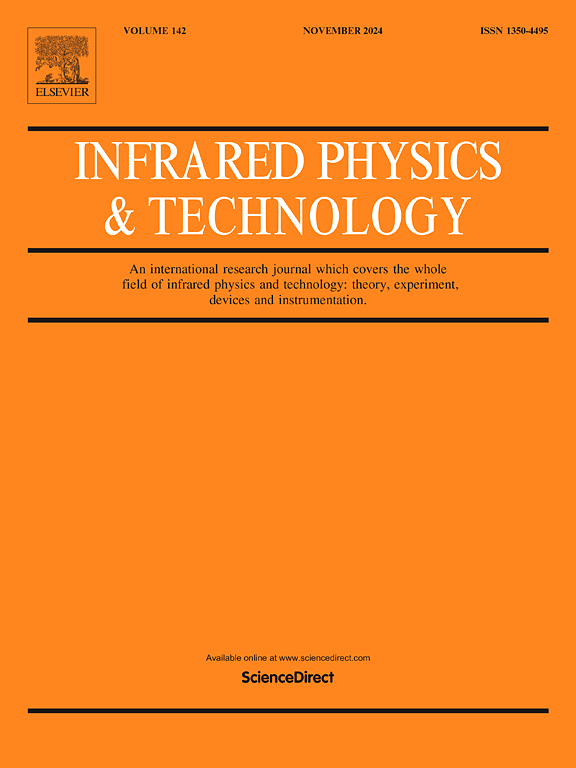Fabrication, microstructure and infrared optical properties of polycrystalline diamonds through surface seeding optimization
IF 3.1
3区 物理与天体物理
Q2 INSTRUMENTS & INSTRUMENTATION
引用次数: 0
Abstract
This study systematically investigated the impact of surface seeding density (5.5 × 108 – 4.6 × 109 cm−2) on the growth behavior, microstructure, and optical performance of polycrystalline diamond films synthesized via microwave plasma chemical vapor deposition (MPCVD). By modulating the composition of diamond suspensions, four samples (S1–S4) with controlled seeding densities were fabricated. Results demonstrated that higher seeding densities could reduce the grain sizes from ∼84 μm to ∼30 μm, lower the surface roughness (Sa: 3.81 μm to 1.53 μm), and enhance crystallinity, as were confirmed by TEM, EPR, and Raman spectroscopy. Under a seeding density of 2.7 × 109 cm−2, diamonds exhibited optimal performance with minimal lattice defects, low residual stress (0.07 GPa), and the highest infrared (IR) transmittance (∼70.9 % at 12 μm). Subsequent deposition of Y2O3 anti-reflective coatings on diamond substrates achieved an average transmittance of ∼93.3 % (peak: ∼96.1 %) in the 8–12 μm range, with only 4.4 % loss after thermal cycling at 800 °C. The work has established a quantitative relationship between seeding density, structural integrity, and optical properties, offering a scalable strategy for producing high-quality polycrystalline diamond materials with exceptional thermal stability and IR transparency. These advancements highlighted the material’s potential for demanding applications, such as IR windows in high-speed aircraft and high-temperature optical systems.

通过表面播种优化多晶金刚石的制备、微观结构和红外光学性能
本研究系统地研究了表面播种密度(5.5 × 108 ~ 4.6 × 109 cm−2)对微波等离子体化学气相沉积(MPCVD)制备的多晶金刚石薄膜生长行为、微观结构和光学性能的影响。通过调节金刚石悬浮液的组成,制备了四种具有可控播种密度的样品(S1-S4)。TEM、EPR和拉曼光谱结果表明,较高的播种密度可以将晶粒尺寸从~ 84 μm减小到~ 30 μm,降低表面粗糙度(Sa: 3.81 μm至1.53 μm),并提高结晶度。在2.7 × 109 cm−2的播种密度下,金刚石的晶格缺陷最小,残余应力低(0.07 GPa),红外透射率最高(12 μm时为70.9%)。随后在金刚石衬底上沉积的Y2O3抗反射涂层在8-12 μm范围内的平均透射率为~ 93.3%(峰值为~ 96.1%),在800°C热循环后仅损失4.4%。这项工作建立了播种密度、结构完整性和光学性质之间的定量关系,为生产具有优异热稳定性和红外透明度的高质量多晶金刚石材料提供了可扩展的策略。这些进步突出了该材料在高要求应用领域的潜力,例如高速飞机和高温光学系统中的红外窗口。
本文章由计算机程序翻译,如有差异,请以英文原文为准。
求助全文
约1分钟内获得全文
求助全文
来源期刊
CiteScore
5.70
自引率
12.10%
发文量
400
审稿时长
67 days
期刊介绍:
The Journal covers the entire field of infrared physics and technology: theory, experiment, application, devices and instrumentation. Infrared'' is defined as covering the near, mid and far infrared (terahertz) regions from 0.75um (750nm) to 1mm (300GHz.) Submissions in the 300GHz to 100GHz region may be accepted at the editors discretion if their content is relevant to shorter wavelengths. Submissions must be primarily concerned with and directly relevant to this spectral region.
Its core topics can be summarized as the generation, propagation and detection, of infrared radiation; the associated optics, materials and devices; and its use in all fields of science, industry, engineering and medicine.
Infrared techniques occur in many different fields, notably spectroscopy and interferometry; material characterization and processing; atmospheric physics, astronomy and space research. Scientific aspects include lasers, quantum optics, quantum electronics, image processing and semiconductor physics. Some important applications are medical diagnostics and treatment, industrial inspection and environmental monitoring.

 求助内容:
求助内容: 应助结果提醒方式:
应助结果提醒方式:


